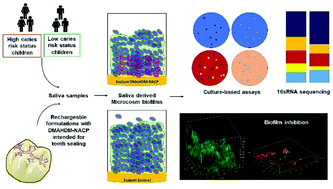Multifunctional antibacterial dental sealants suppress biofilms derived from children at high risk of caries
Abstract
Dental caries in children is a leading worldwide oral health concern. Combining antibacterial and remineralizing additives within dental sealants is a promising approach for caries prevention. Saliva contains oral bacteria that are indicative of the whole oral microbiome and may have the ability to reflect the dysbiosis present in patients with dental caries. Here, we used the saliva of children at a low and high risk of caries to culture microcosm biofilms resembling caries-associated microbial communities and investigated the changes in the biofilms promoted by the formulated dental sealants containing dimethylaminohexadecyl methacrylate (DMAHDM), a quaternary ammonium monomer, and nanoparticles of amorphous calcium phosphate (NACP). Ten volunteers were selected from each caries-risk condition for saliva collection. Biofilms were grown on the tested sealant samples using a 48 h-microcosm biofilm model. The biofilm growth, metabolic behavior, and bacterial acid production were combined with 16S rRNA sequencing analysis for the assessment of the biofilm grown over the material. The DMAHDM-NACP dental sealant formulations promoted a significant reduction in the population of mutans streptococci, total streptococci, lactobacilli, and total microorganisms in the biofilms regardless of the risk status of the donor child's saliva (p < 0.05). Metabolic and lactic acid production was greatly reduced when in contact with the DMAHDM-NACP sealants in both the sources of inoculum. The relative abundance of the Streptococcus genera derived from patients at a high risk of caries was reduced on contact with the antibacterial sealant. The dental sealant formulations were effective in modulating the growth of the biofilm derived from the saliva of children at a low and high risk of caries. The sealants formulated herein with dual functions and purpose for biointeractivity to prevent biofilm formation and mineral loss can be a reliable complementary strategy to decrease the incidence of carious lesions in children at a high risk of caries.



 Please wait while we load your content...
Please wait while we load your content...